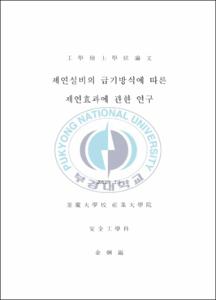制煙設備의 急機方式에 따른 制煙效果에 관한 硏究
- Abstract
- 본 연구 대상 건축물은 판매시설, 멀티플렉스 영화관, 버스 여객 터미널 등이 설치된 복합건축물로 거실제연을 공기 유입방식에 따라 제연효과를 비교하기 위하여 거실의 바닥 면적이 400㎡이상으로 구획된 제연구역에 대하여 동일실 제연방식인 자연 유입방식과 강제 유입방식에 대하여 실험을 행하였으며 인접구역 상호 제연방식인 인접구역 유입방식에 대해서도 동일한 제연구역에서 실험하여 제연효과를 비교하였다.
본 연구에서는 거실 제연설비의 공기 유입방식(자연 유입방식, 강제 유입방식 및 인접한 제연구역 유입방식)에 따른 제연효과를 비교 검토하기 위하여 Hot smoke를 이용하여 수행하였다. 본 연구의 결과로 다음과 같은 결론을 얻었다.
(1) 자연 유입방식은 배출량이 급기량 보다 크므로 배기시킨 공간으로 연기가 유입된다. 따라서 화재 시 개구부를 통하여 배출량 이상의 급기 풍량을 확보하기가 불가능 하므로 현실적으로 적용할 수가 없다.
(2) 강제 유입방식은 동일실에서 급기와 배기가 동시에 실시되므로 실내의 기류가 난기류가 되어 청결층(clear layer) 형성을 방해한다. 급기구의 풍속을 NFSC 501에서는 5 m/s이하로 하도록 되어있으나 급기구의 풍속이 커서 실내의 기류가 난기류가 되므로 NFPA 204에서는 1.02 m/s 이하로 제한하고 있는 것이 타당하다고 본다. 그러므로 화재실이 소규모이면서 유입구 풍속을 낮추기 위해 유입구를 분산 설치하여 유입량을 낮추어야 한다.
(3) 인접구역 유입방식은 청결층(clear layer) 형성이 장시간 유지되나 시간이 경과할수록 제연 경계벽에서 연기가 흩어지는 경향이 있다. 넓은 공간의 사용이 요구되는 백화점 등의 판매시설과 같은 대형 건물에 사용 되어야 한다.
(4) 자연 유입방식은 현실적으로 적용이 불가능하며 강제 유입방식은 소규모의 거실에 적용 하여야 한다. 또한 인접구역 유입방식은 대규모 거실에 적용하는 것이 가장 효과적이다.
In this study, a comparison of smoke control effects from air inlet methods composed of natural inflow system, forced inflow system and adjacent area inflow method were conducted in the complex structures, such as the multiplex cinema and passenger terminal from the bus station as an indoor experiment, targeting a smoke control compartment with floor area of more than 400㎡.
This study was designed to compare the smoke control effects according to different air inflow methods (natural inflow system, forced inflow system and adjacent area inflow system) in indoor smoke control systems, where the experiment was conducted using hot air. The results of this study are as follows.
(1) In case of natural air inflow system, since the emissions are larger than the amount of air supply, smoke flows into the discharged area, which makes it impossible to secure enough air supply amount to control emissions. Accordingly, it is judged that the method cannot be applied in real life cases.
(2) In case of forced air inflow system, since air supply and exhaust are made in the same room at the same time, the indoor air flow becomes turbulent air to interfere with the formation of clear layer. According to the NFSC 501, wind speed is set as less than 5 m/s, but the wind speed is required to be limited to less than 1.02 m/s in NFPA 204 since the indoor air flow becomes turbulent air due to a high wind speed of air inlet. Accordingly, to decrease the wind speed, air flow needs to be reduced through distributed installation of inlet.
(3) Adjacent area inflow system has its advantage of forming clear layer, which maintains for a relatively long time, but the smoke tends to be dispersed in the smoke control boundary walls. This system is recommended to be used for large buildings including sales facilities of department stores, which require the use of open spaces.
(4) In conclusion, the natural inflow system cannot be applied in real cases, and the application of the forced inflow system is available only in small living rooms. In case of adjacent area inflow system, it is most effective when applied in large living room.
- Issued Date
- 2012
- Awarded Date
- 2012. 2
- Type
- Dissertation
- Publisher
- 부경대학교 대학원
- Department
- 산업대학원 안전공학과
- Advisor
- 최재욱
- Table Of Contents
- 목 차
1. 서 론
1.1 연구배경 및 목적 1
1.2 연구동향 3
1.3 연구범위 6
2. 이론적 배경 7
2.1 제연구역 설정 7
2.2 배출량 7
2.2.1 거실 바닥면적이 400㎡ 미만인 경우 7
2.2.2 거실 바닥면적이 400㎡ 이상인 경우 8
2.3 배출구 9
2.3.1 바닥면적이 400㎡ 미만인 경우 9
2.3.2 통로인 예상제연구역과 바닥면적이 400㎡ 이상인 경우 10
2.4 공기유입방식 및 공기유입구 10
2.5 공기 유입구크기, 공기 유입량, 배출구 수평거리 12
2.6 제연 방식 12
2.7 연기 발생량 13
2.8 화재 둘레에 의한 연기 하강 시간 및 연기 배출량 15
2.9 화재의 둘레(길이) 19
2.10 감광계수 19
2.11 가시거리 20
3. 실험방법 21
3.1 Hot smoke test 22
3.1.1 실험장치 22
3.1.1.1 Hot smoke 발생기 22
3.1.1.2 풍량계 23
3.1.1.3 풍속계 23
3.1.1.4 조도계 25
3.2 연기 배출량 25
3.3 공기 급기량 및 급기구 면적 27
3.4 실험 순서 28
3.4.1 동일실 제연방식 중 자연 급기방식에 따른 제연 효과 29
3.4.2 동일실 제연방식 중 강제 급기방식에 따른 제연 효과 30
3.4.3 인접구역 상호제연방식 중 인접구역 급기방식에 따른 제연 효과
31
4. 결과 및 분석 32
4.1 자연 유입방식의 경우 32
4.2 강제 유입방식의 경우 36
4.3 인접구역 유입방식의 경우 41
4.4 자연유입방식, 강제유입방식, 인접구역 유입방식의 비교 45
5. 결론 48
참고문헌 50
Abstract 52
감사의 글 54
- Degree
- Master
- Files in This Item:
-
-
Download
 制煙設備의 急機方式에 따른 制煙效果에 관한 硏究.pdf
기타 데이터 / 2.02 MB / Adobe PDF
制煙設備의 急機方式에 따른 制煙效果에 관한 硏究.pdf
기타 데이터 / 2.02 MB / Adobe PDF
-
Items in Repository are protected by copyright, with all rights reserved, unless otherwise indicated.